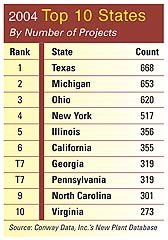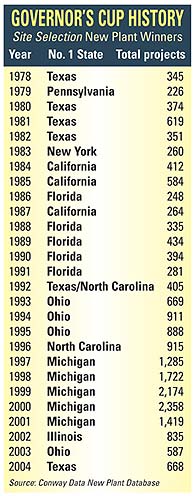s if to underscore its claim to the 2004 Governor’s Cup, Texas ended the calendar year with a December new-jobs announcement that dwarfs the number of jobs associated with any of the more than 660 qualifying projects that won the state the award. Countrywide Financial will add 7,500 employees to its payroll in the state, mostly at its operation in Richardson, which as part of the Dallas-Ft. Worth metro area enjoys top billing as a 2004 Top Metro (see page 154). And January 2005 saw a 1,600-job, US$100-million investment from Tyson Foods for a meat-packing plant in Sherman.
Site Selection publisher
Conway Data, Inc., has been tracking business expansion activity for more
than 40 years. The Governor’s Cup and other awards bestowed by the magazine
are determined by the number of qualified projects logged into Conway
Data’s New Plant database. Qualifying projects involve a capital investment
of at least $1 million, create 50 or more jobs or involve new floor space
of at least 20,000 square feet (1,860 sq. m.).
Texas lured enough such projects, large and small,
in 2004 to bring the Governor’s Cup back to the South after several years
of
|
Midwestern winners. Texas last won in 1992, when it shared the prize with
North Carolina, but the Lone Star State is no stranger to back-to-back
individual wins with a three-peat occurring in 1980, ’81 and ’82 (see
the historical chart oat right). At the rate Texas is racking up new facilities
lately, and with a business climate ranked first in the U.S. by this publication
(see the November 2004 cover story), it could happen again.
Central to Texas’ ability to lure projects is the $295-million
Texas Enterprise Fund (TEF) authorized by the legislature in 2003 to help
seal deals that might have gone elsewhere. More than $200 million of the
fund has been spent so far, resulting in more than 22,000 new jobs at
Texas Instruments, Countrywide Financial and numerous other projects,
including the new Tyson Foods plant.
“The clincher on that project was the Enterprise Fund,” says Gov. Rick Perry. “We had some stiff competition from Durant, Oklahoma, just across the border. We enjoy beating Oklahoma from time to time — we’re having a hard time doing that on the football field, so we’ll have to do it on the economic development front.”
The governor has asked the current legislature to
raise the TEF allocation to $300 million to give him the tools needed
to deliver job growth. But there are other arrows in his quiver, and the
legislature itself deserves some credit, says the governor. “The legislature
demonstrated disciplined fiscal responsibility in dealing with the 2003
budget, where we faced a $10-billion budget deficit. Rather than take
the easy way out by raising taxes and telling people it was too big a
deficit to deal with solely by reducing spending, we didn’t do that. I
share that fiscal restraint with the lieutenant governor, David Dewhurst,
and the Speaker, Tom Craddick, and with their leadership. It was a team
effort of people who are committed fiscal conservatives. Texas is a textbook
example of growing your way to prosperity,” he notes. “You do not tax
your way to prosperity.”
A focus on education yields a skilled work force,
and despite the budget deficit, the legislature allocated over $1 billion
in new funding to public schools, notes the governor. “That, coupled with
the restraint on spending, sent a real message to the business community
that not only do we get it from the standpoint of tax policy, but we also
get it by continuing to support a skilled work force in the state.”
Texas’ regulatory climate is fair and balanced, he
adds, pointing to passage in 2003 of a tort reform bill. “That bill is
now perceived to be a national model for other states,” says Gov. Perry.
“The message to the business community is that you can come to the state,
risk your capital and know that you will not be sued frivolously. It’s
powerful legislation,” he adds. “The Wall Street Journal called it ’10-Gallon
Tort Reform.’ As the president goes forward with national tort reform,
we wish him every bit as much good luck and godspeed as what we’ve had
in Texas with it.”
Still, the role of the Enterprise Fund cannot be
overstated. “The
legislature’s committing $295 million to that fund was a short-term
difficult decision to make because of the economic situation we were
in,” says Perry. “But long term, it was very visionary relative to the
job creation climate in Texas. No other state in the nation has had
the type of turnaround economically that Texas has had.” Indeed, the
state comptroller announced recently that the state had $6.4 billion
more to spend than what could be spent in the last budget cycle, which
should help give the Enterprise Fund a new lease on life. 
But the governor has another ace up his sleeve.
He is seeking from the legislature an additional $300 million for the
creation of the Texas Emerging Technology Fund (TETF). Half the funding
would be dedicated to creating “regional centers of innovation and commercialization”
to be developed jointly by institutions of higher education and the
private sector. Two such centers already exist — Sematech in Austin
and the Center for Advanced Diagnostic Imaging in Houston.
One quarter of TETF, or $75 million, would be used
to match research grants awarded by federal or private sponsors. The
funds will help in-state researchers compete for out-of-state dollars,
because sponsors will know that their investment will have double
the impact. The remaining $75 million will be used to attract renowned
out-of-state research teams to Texas universities.
“My vision here is to create a way that in four
or five years you have enough [commercialization of] these technologies
to create enough wealth to perpetuate the fund,” says Gov. Perry. “The
return on investment can be tremendous with some of these concepts.”










 competition.
competition.